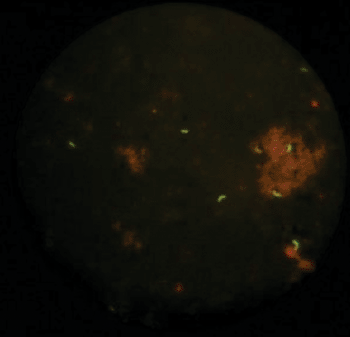Forgotten Vital Stain Identifies Resistant TB
By LabMedica International staff writers
Posted on 14 Aug 2012
Vital staining with fluorescein diacetate (FDA) stains only living Mycobacterium tuberculosis tuberculosis bacilli so that only those bacilli resistant to treatment are seen.Posted on 14 Aug 2012
Scientists improved the detection of the luminous bacilli by replacing the classical fluorescence microscope with its light-emitting diode (LED) counterpart. Together with colleagues in Bangladesh, scientists at the Antwerp Institute of Tropical Medicine (Belgium) tested the approach in the field for four years. If after treatment the FDA-test was negative, in 95% of cases more elaborate tests did not find active bacilli in the patient's sputum. And if the test was positive, a resistant bacillus had been found.

Image: Result of an FDA-test under the microscope: the fluorescent lines are living tuberculosis bacilli, on a background of cellular debris from human sputum (Photo courtesy of ITG).
Tuberculosis bacilli that have become resistant to major antibiotics are a serious threat to world health. Checking smears under the microscope is the recommended technique for TB screening, but it cannot differentiate between living and dead bacilli. Therefore, it is not possible to know whether the bacilli observed are cadavers after a successful treatment, or resistant survivors. Only if the numbers do not decrease after a long wait, you know you are dealing with a resistant strain. But all that time the patient remains contagious.
With high-tech PCR technology, one can immediately ascertain if the bacillus is from a resistant strain, but in practice and certainly in resource-limited countries, this is unfeasible. It also is impossible to cultivate every sample and then bombard it with every possible antibiotic to survey which ones still work for that individual patient.
In 1991, a tuberculosis bug in New York was found to be resistant to 11 antibiotics. Cases have been reported where every antibiotic was useless. So far, these “omniresistant” bacilli each time perished with their host before they could spread. So far, that is. The highest numbers were all registered in the former Soviet Union.
Tuberculosis bacilli that have become resistant against the major antibiotics are a serious threat to world health.
To prevent an epidemic of difficult-to-treat tuberculosis, resistant cases, which do not react to the normal treatment, need to be recognized as early as possible, and immediately treated with second-line antibiotics that still work. But the laboratory tests to identify resistant TB bugs are cumbersome––the WHO estimates that in 2009 only 11% of multiresistant cases were discovered.
The FDA staining approach of Armand Van Deun and colleagues in the field for four years is very promising especially as it can be used in low-resource countries.
Related Links:
Antwerp Institute of Tropical Medicine
World Health Organization













